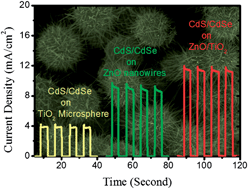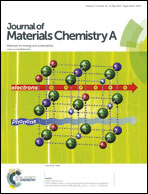Highly efficient photoelectrochemical response by sea-urchin shaped ZnO/TiO2 nano/micro hybrid heterostructures co-sensitized with CdS/CdSe†
Abstract
Photoelectrochemical cells have existed for decades. However, the poor efficiency of such devices is still problematic because of trade-offs between different materials properties used for photoelectrochemical reactions. Here we report a novel photoanode architecture consisting of CdS/CdSe co-sensitized sea urchin-shaped ZnO/TiO2-based nano/micro hybrid heterostructures that simultaneously offer better light scattering over the entire visible frequency domain, better separation of photo-generated charge carriers, significantly improved light absorption that extends over a broad visible spectrum, and better transport of electrons through a highly connected network of conducting ZnO nanowires than existing architectures. Use of the synthesized structures as photoanodes in a photoelectrochemical cell yielded a photocurrent density as high as 11.8 mA cm−2 with a remarkable photo-conversion efficiency of 6.4%.


 Please wait while we load your content...
Please wait while we load your content...